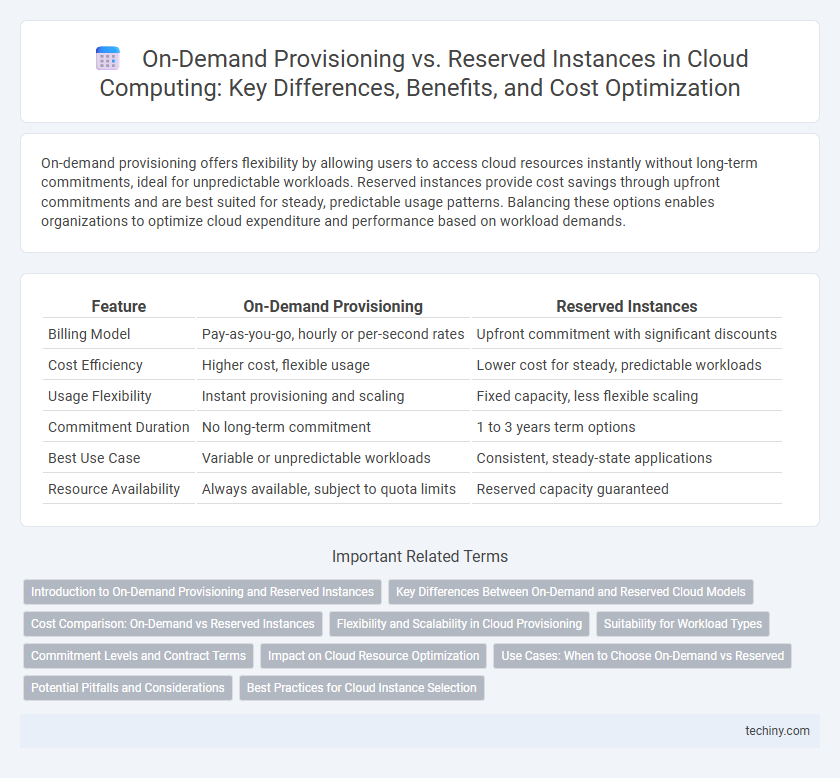On-demand provisioning offers flexibility by allowing users to access cloud resources instantly without long-term commitments, ideal for unpredictable workloads. Reserved instances provide cost savings through upfront commitments and are best suited for steady, predictable usage patterns. Balancing these options enables organizations to optimize cloud expenditure and performance based on workload demands.
Table of Comparison
| Feature | On-Demand Provisioning | Reserved Instances |
|---|---|---|
| Billing Model | Pay-as-you-go, hourly or per-second rates | Upfront commitment with significant discounts |
| Cost Efficiency | Higher cost, flexible usage | Lower cost for steady, predictable workloads |
| Usage Flexibility | Instant provisioning and scaling | Fixed capacity, less flexible scaling |
| Commitment Duration | No long-term commitment | 1 to 3 years term options |
| Best Use Case | Variable or unpredictable workloads | Consistent, steady-state applications |
| Resource Availability | Always available, subject to quota limits | Reserved capacity guaranteed |
Introduction to On-Demand Provisioning and Reserved Instances
On-demand provisioning in cloud computing allows users to instantly allocate resources without long-term commitments, providing maximum flexibility and scalability for fluctuating workloads. Reserved instances offer a cost-saving model by requiring upfront commitment to a specific usage term, ideal for predictable and steady-state workloads. Choosing between on-demand provisioning and reserved instances depends on balancing budget constraints with performance requirements and workload patterns.
Key Differences Between On-Demand and Reserved Cloud Models
On-demand provisioning offers instant access to cloud resources with flexible billing based on actual usage, ideal for unpredictable workloads and short-term projects. Reserved instances require upfront commitment for a fixed term, providing significant cost savings and capacity guarantees suited for steady, predictable workloads. Choosing between these models hinges on balancing the need for scalability and budget optimization in cloud resource management.
Cost Comparison: On-Demand vs Reserved Instances
On-demand provisioning incurs higher hourly rates, making it costlier for continuous workloads compared to reserved instances, which offer significant discounts of up to 75% in exchange for long-term commitment. Reserved instances optimize cost efficiency by allowing users to pre-pay or commit to usage over one or three years, thereby reducing overall expenditure for predictable cloud resource needs. Businesses with variable workloads benefit from the flexibility of on-demand pricing despite its premium cost, whereas reserved instances provide substantial savings for stable, steady-state environments.
Flexibility and Scalability in Cloud Provisioning
On-demand provisioning offers unmatched flexibility by allowing users to instantly allocate and release cloud resources based on real-time demand, supporting dynamic workloads without long-term commitments. Reserved instances provide cost efficiency for predictable usage patterns but limit scalability due to fixed capacity and upfront commitment periods. Enterprises balancing workload variability and budget constraints often combine both models to optimize resource utilization and operational agility in cloud environments.
Suitability for Workload Types
On-demand provisioning offers flexibility and scalability ideal for unpredictable or fluctuating workloads, enabling instant resource allocation without long-term commitments. Reserved instances provide cost-effectiveness and stability for steady, predictable workloads by committing to capacity over a fixed term with lower hourly rates. Choosing between the two depends on workload consistency, with on-demand suited for variable usage patterns and reserved instances optimized for continuous, consistent demand.
Commitment Levels and Contract Terms
On-demand provisioning in cloud computing allows users to access resources with no long-term commitment, offering maximum flexibility and pay-as-you-go pricing. Reserved instances require a commitment to a specific contract term, typically one to three years, providing significant cost savings in exchange for upfront or partial payments. The choice between these models depends on workload predictability and financial strategy, balancing the need for scalability against cost optimization.
Impact on Cloud Resource Optimization
On-demand provisioning enables flexible and scalable access to cloud resources, allowing businesses to optimize workload performance by dynamically allocating computing power based on real-time demand. Reserved instances provide cost-efficient resource allocation through long-term commitments, improving cost predictability and maximizing utilization of cloud assets. Combining both models enhances cloud resource optimization by balancing flexibility with cost savings, ensuring efficient infrastructure management aligned with varying workload patterns.
Use Cases: When to Choose On-Demand vs Reserved
On-demand provisioning excels for unpredictable workloads and short-term projects, offering flexibility without upfront commitments. Reserved instances suit steady-state applications and predictable usage patterns, delivering cost savings through long-term reservations. Choosing between them depends on workload stability, budget constraints, and scalability requirements in cloud infrastructure management.
Potential Pitfalls and Considerations
On-demand provisioning offers flexibility without long-term commitment but can lead to higher costs due to unpredictable usage patterns and lack of discounts. Reserved instances provide cost savings through upfront payment and capacity reservation, yet they risk underutilization if demand decreases or overcommitting resources. Organizations must carefully analyze workload consistency, budget constraints, and forecast accuracy to avoid inefficiencies and optimize cloud expenditure.
Best Practices for Cloud Instance Selection
Choosing between on-demand provisioning and reserved instances depends on workload predictability and cost management goals. On-demand instances offer flexibility for variable or short-term workloads, ensuring immediate availability without long-term commitment. Reserved instances provide significant cost savings for steady-state or predictable usage by committing to a fixed term, optimizing budgeting and resource utilization in cloud environments.
On-Demand Provisioning vs Reserved Instances Infographic

 techiny.com
techiny.com